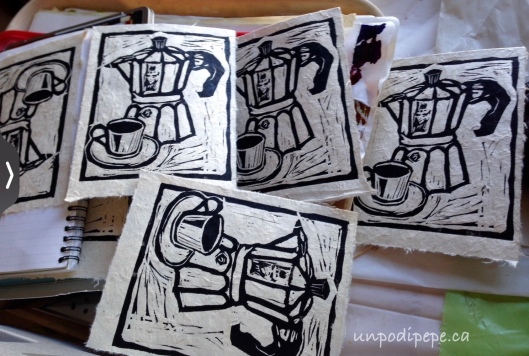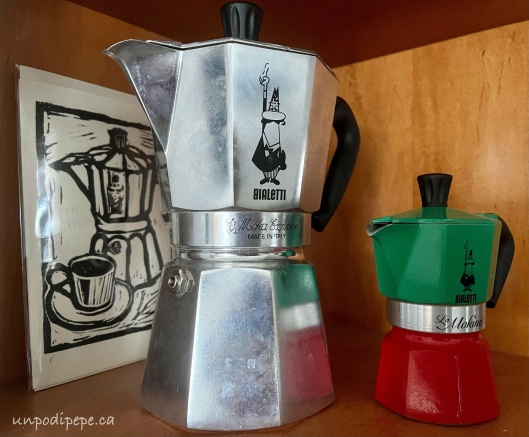 The Bialetti Moka caffettiera (coffee maker) is an icon of Italian design, along with the Vespa and Fiat Cinquecento. An economical, easy to use product, the Moka revolutionized the coffee habits of Italian households around the world. It is a time-tested piece of functional art and part of the permanent collection of MoMA, the Museum of Modern Art in New York.
The Bialetti Moka caffettiera (coffee maker) is an icon of Italian design, along with the Vespa and Fiat Cinquecento. An economical, easy to use product, the Moka revolutionized the coffee habits of Italian households around the world. It is a time-tested piece of functional art and part of the permanent collection of MoMA, the Museum of Modern Art in New York.
Alfonso Bialetti spent 10 years in France working as a smelter, learning to cast aluminum shells. These were cast iron molds able to produce multiple copies of the same object. When Alfonso returned to Italia in 1919, he opened a workshop producing aluminum parts.
In 1933, Bialetti built his first coffee maker or caffettiera all thanks to ….laundry! He was inspired by watching wife Ada use the lisciveuse, a French ancestor to the washing machine. It was a steel tub, an insert with a central perforated chimney, and a lid. Clothes and soap were placed inside, then it was filled ¾ of the way with water and placed on the fire. Boiling water ‘percolated’ up the chimney and fell on the wet clothes.
Bialetti’s caffettiera had 3 parts: a cast aluminum boiler with an octagonal base, a funnel shaped strainer and an angular pitcher with a hinged lid. Pressurized-water heats in the boiler and steam forces water upward through coffee grounds in the funnel and into the top pitcher chamber. His design was inspired by Art Deco architecture and Signora Bialetti! Her broad shoulders, narrow waist, pleated skirt, and arm on her hip are reflected in the Moka design.
Bialetti produced at an artisanal level, selling 10,000 caffettiere per year at markets all over Piemonte. Sales were interrupted by WW2 and a shortage of aluminum. Alfonso’s son Renato was a prisoner of war in Germany for 2 years and took over the company when he returned. Renato had a modern marketing vision, with an ad strategy that included the 1948 Fiera di Milano, installations, billboards and an export plan. He took production to an industrial level.
Renato named their product ‘Moka Express’. ‘Moka’ for the city of Mokha in Yemen, a historic exporter of quality coffee, and ‘Express’ because espresso could now be made at home, without having to go to the bar. The Moka design and safety valve were patented in 1950.
 In 1953 Renato became the actual face of his product with the famous cartoon logo printed on every Moka. ‘L’Ometto con i baffi’– the little man with a moustache. His finger is raised, as if ordering an espresso. Billboards and TV commercials made him an advertising icon. By 1956 18,000 Moka per day (4,000,000 per year) were produced. To date, 300 million have been produced.
In 1953 Renato became the actual face of his product with the famous cartoon logo printed on every Moka. ‘L’Ometto con i baffi’– the little man with a moustache. His finger is raised, as if ordering an espresso. Billboards and TV commercials made him an advertising icon. By 1956 18,000 Moka per day (4,000,000 per year) were produced. To date, 300 million have been produced.
The original Moka was a 3 tazze (3 espresso cups) size, for single or small family use. Now it is available in the tiny ½ tazza Mokina to the 18 tazze Moka Express.  Also available are stainless steel models, the cow-hide patterned Mukka Express that froths milk at the same time-making a cappuccino, electric plug-in models, and even a red Dolce & Gabbana patterned Moka! I so need one of those! I love Franco’s green ‘Alpina‘ model with the Alpini hat and feather!
Also available are stainless steel models, the cow-hide patterned Mukka Express that froths milk at the same time-making a cappuccino, electric plug-in models, and even a red Dolce & Gabbana patterned Moka! I so need one of those! I love Franco’s green ‘Alpina‘ model with the Alpini hat and feather!
When Renato Bialetti died in 2016 at age 93, his ashes were placed in a specially made large Moka. It was about the size of this one…..
My 3 cup size, in the following photo, and the red one in the olive grove are the ‘Moka Dama‘. A few of the features are different, but the design always remains similar to the original ‘retro’ look.
1 Pour room temperature water into the boiler until it reaches the safety valve. More water will result in watery caffè – or ‘acqua di cicoria’, as mamma calls it!
2 Drop the funnel into the boiler and fill generously with espresso ground coffee -avoid pressing it down
3 Place Moka on a small burner with a low flame
4 When you hear the gorgoglio – the gurgling sound, caffè is ready. Remove from the burner and enjoy.
Since aluminum is porous, it absorbs the coffee aroma over time and improves its taste. With a new Moka, ‘season’ it by making 2 consecutive pots and throwing out the caffe. If the Moka has not been used for a long time, make a pot with just water, and also throw out the first pot of caffè. Do not clean with detergent, just warm water. Do not put your Moka in the dishwasher! A well-used Moka with a patina makes the best caffè. The rubber gasket needs to be replaced every year or so, depending on how much it is used. If taken care of, the Moka will last a lifetime.
 The Moka is an eco-friendly, sustainable way to make caffè. There is zero waste -the grounds are 100% organic and compostable, no detergents are needed, it is long-lasting and made of 100% recyclable aluminum.
The Moka is an eco-friendly, sustainable way to make caffè. There is zero waste -the grounds are 100% organic and compostable, no detergents are needed, it is long-lasting and made of 100% recyclable aluminum.
90% of Italian kitchens have a Moka. Alfono Bialetti described the Moka as ‘fast, strong and resistant, like caffeine’. With the Moka, a daily act was revolutionized, as caffè almost as good as you could get at the bar was brought into homes ‘in casa un espresso come al bar’.
The photos in this post are of Moka caffettiere that belong to me or family members, and some were taken at the Bialetti store at the Centro Commercial GrandApulia. The cartoon is from the Bialetti website. Do you have a Moka?
***Somehow, I missed the fact that the previous post was my 200th! So……to celebrate this milestone, I am giving away 2 signed copies of my linocut edition on handmade paper ‘Espresso per uno’. Next week, I will put the names of everyone who left a comment on this post into a hat and draw 2 winners. In bocca al lupo! Ciao, Cristina


Grazie mille per il tuo articolo sulla Moka caffettiera. Era molto interessante! Sarò in Italia mercoledì prossimo! Non vedo l’ora di vedere Sicilia e Puglia!
Prego Daniel e buon viaggio! Forse in Sicilia puoi trovare un Moka D& G! Saluta la Puglia per me-io vado a Luglio. Ciao, Cristina
Wow – congratulations on 200 posts! That is amazing dedication. We have many moka pots in our house as Signor Martini is a big fan and has a small collection, including some sentimental hand me down ones. I didn’t drink coffee before I was married, but I have had one every morning since then as it is so good when it is hot from the pot. My suoceri also have several, including one with a goat bone attached as a replacement handle! Nonno is very attached to it. I will try to post a picture of our collection!
Grazie Signora Martini! I can’t believe how time flies. In a few weeks it is my 9th bloghiversary! Love the goat bone handle-I had one with an olive wood handle and head, but because we weren’t able to go to our casetta in Italia for 3 years, it got rusty and was thrown out! I would have kept the handle. Mannaggia! It was hard to pick the ones for the post-so many to choose from. Now I need to get my hands on the red D & G model. Ciao, Cristina
great Cristina, this weekend I travelled with my Moka to Mayne Island. I bought mine in a supermercado in Cosenza, Calabria.
Yeah, a travelling Moka!
and congrats on your 200th!!! A milestone!
Grazie Eloise!
Great post! I’m not a coffee drinker but I love the styles and the story – the Alpini hat moka is just too funny. And congrats on your 200th post!
Grazie Karen! Franco’s father was an actual Alpino during the war, so I got him the Alpina 🪶. I love the washing machine inspiration. Probably the only thing laundry has ever inspired 🤣🤣🤣
I love your posts. I learned something, as usual! I always pack the coffee grounds, I won’t anymore. I already have a copy of your linocut espresso pot that you gifted me Orsara. It is beautiful and hangs in my kitchen. Congratulations on your 200th post.
Grazie Maria! I think a lot of people do that, because that is what the way it’s done for the big machines. Baci, Cristina
Congratulations on 200 posts; I enjoy your page so much! I have a collection of espresso makers, and my Bialetti is my favourite.
Congratulations on 200 posts; I enjoy your page so much! I have a collection of espresso makers, and my Bialetti is my favourite.
Congratulations on 200 posts! I’m really enjoying them. Of all the espresso makers I have, my Bialetti Moka is my favourite.
Grazie Joanne! I enjoy writing them-and it’s nice to know someone is reading and enjoying 😍 ciao, Cristina
Huh! I could swear I had left a comment, but the mysterious WordPress goblins must have rejected it. Never mind, eh? I love my Moka and use it several times a day. The sounds and smells as it goes about its work always take me back to happy times in Italy.
WordPress goblins are always hard at work Yvonne! Don’t you love the fact that there is an actual word for the gurgling sound ‘gorgoglio’? My favourite part has to be the aroma ☕️ of fresh gurgling caffè! Ciao, Cristina
Great info on the Moka. Congrats on your 200 th. 🤗
Grazie Patty! I will now always think of laundry when I use mine 😎. Ciao, Cristina
Love this post!
Grazie Anna!
Loved the story and the history. Anna forgot to say we took one to our place in Mexico
Grazie Terry. Got to have a Moka in every location ☕️! Ciao, Cristina
Pingback: Bloghiversario #9 | Un po' di pepe
Such a fabulous post. I have 5 Bialetti Moka pots. One I still have and still use (even this morning) I brought back from Firenze when I was in school there in`66-`67. (Yes, I am that old.) One time I bought a different brand made out of stainless steel. It made terrible coffee. It needs to be the aluminum pot. Thank you for this history. Tanti saluti!
Pamela, your Moka is as old as me! That’s amazing! You are right-need to stick with the original. Ciao, Cristina